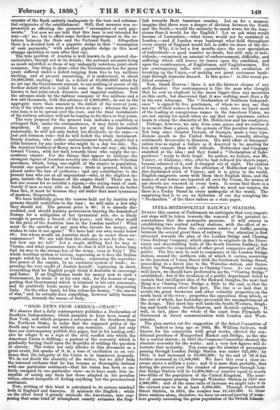LNTRA-METROPOLITAN RAILWAY STATIONS.
DtraiNo this session of Parliament we anticipate that very import- ant steps will be taken towards the removal of the greatest in- convenience that the metropolis presents. It will consist in establishing two central railway stations, with the effect of re- lieving the streets from the enormous armies of traffic, passing between the several great lines of railway. Our attention is first attracted towards the plan of the London Bridge and Charing Cross Railway Company, which appears to originate in the Direc- torate and shareholding body of the South Eastern Railway, but which courts the cooperation of other great companies and of the public. The line may be said to commence at the London Bridge station, around the northern side of which it curves, recurring to the junction of Union Street with the Southwark Bridge Street, proceeding in a direct line to the Waterloo station, and thence direct by Hungerford Bridge to Charing Cross. As our readers well know, we should have preferred to see the "Charing Bridge" established ; but if the weakness of a public department failed to sustain that intelligent idea of Sir Howard Douglas, the next best thing is a Charing Cross Bridge a little to the east, so that the Thames be crossed about that part. The line is so laid that it avoids the great breweries and other valuable properties on the south bank of the river ; properties the opposition from which, or the cost of which, has heretofore prevented the accomplishment of the design. This short line will unite the South-Western, Brigh- ton and South Coast, South-Eastern, and Kentish railways. It will, in fact, place the whole of the coast from Plymouth to Gravesend in direct communication with London and West- minster.
The plan carries out the suggestion of the Select Committee of 1855. Indeed so long ago as 1845, Mr. William Jackson, well known for his connection with great works, effected the con- ditional purchase of Hungerford Market and Bridge as the site for a central station ; in 1855 the Commons Committee : showed the absolute necessity for the works ; and a very few figures will il- lustrate that necessity. Ten years ago the number of passengers passing through London Bridge Station was under 625,000; by 1855, it had increased to 10,000,000; by the end of '58 it has further increased to 13,500,000. We have this year a clear in- crease above a million a year ; and it is more than probable, that during the present year the number of passengers through Lon- don Bridge Station will be 15,000,000—a number equal to nearly two-fifths of the population of the United Kingdom. The num- ber of passengers passing through Waterloo Station in 1857 was 4,000,000; and at the same ratio of increase we might take it in
the current year to be at least 5,000,000. Through Fenehuroh Street Station, in 1855, the number was 10,440,000. In these three stations alone, therefore, we have an annual passing of num- bers greatly exceeding the gross population of the l3rid& Islands
very large proportion of these travellers go over London Bridge ; others find their way in the steam-boats ; the annual passengers of which, exclusively of the halfpenny-boats, are com- puted at 10,000,000. Now, though goods are conveyed at con- siderable lower rates, we know that in value the goods traffic of railways equals the passenger traffic, and it is fair to suppose that the bulk of goods passing between these Railway-stations, and therefore traversing our streets proportionately exceeds the 38, or 40,000,000 of passengers with whom we have already been deal- ing. It is an enormous army, annually struggling its way to those three stations through our narrow streets, with a baggage- train gigantic in proportion. The central station at Charing Cross would not only help to relieve the gorged streets through the length of the Metropolis but would to a great extent provide a local and intermediate traffic, with a corresponding augmentation to the value of the local property.
The other plan has been brought before the public both by business men and by philanthropists it is the formation of a line of railway connecting the Great Western North-Western, and Great Northern stations bringing on the traffic to a Central Ter- minus in Farringdon Street. Mr. Charles Pearson, the originator of the extended scheme, recommends it as one mode of relieving the traffic of the Metropolis which we have already described, and which is at least as great from the Northern sources as it is from the Southern. At the same time Mr. Pearson pointing to the overcrowded condition of the working classes, driven out of their own quarters of the Metropolis by the progress of "improve- ment,' suggests that by a systematic creation of railway transit for them, they may colonize the country districts of the home counties in new and healthy village towns ; coming up to their work in the morning, and going back at night, with immense re-
lief to their own lungs and the lungs of those they leave behind
i , and a corresponding improvement to their own sobriety.. And
here again, the streets of the Metropolis would be restored to that condition of passability, which is 'prevented while some sixty or seventy million travellers annually fight their way through streets built only for thousands. The capital needed for both these commendable projects is really moderate. The Southern scheme demands 800,0001.; the other has 475,000/. already subscribed, and needs but 475,0001. more : the total amount needed, therefore, is under 1,300,009/. The returns on the capital must be immense. The construction of the two termini will inevitably lead to the formation of other intrametropolitan lines traversing the Metropolis through its length and breadth ; and the owners of the termini will be in possession of the portals to that profitable field.



































 Previous page
Previous page